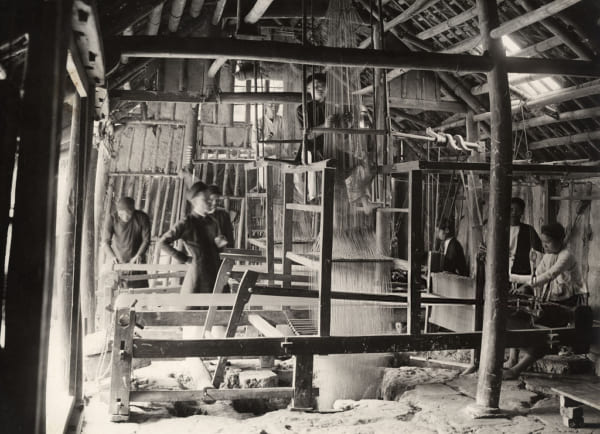Knitted fabric is the most widely used fabric today. Thanks to its features and conveniences, this fabric plays a very important role in our daily lives. So do you know how the formation and history of the knitting industry took place? Let’s find out through the following article.
History of the world knitting industry
The knitting industry is a long-standing industry, with a history that dates back thousands of years. Sweaters, scarves and other knitted fabrics have been found in the archaeological remains of ancient civilizations in Egypt, China, Greece and Rome.

Ancient weaving relics
Initially, knitted fabrics were woven by hand using primitive tools. The first knitting needles were made from bone or bamboo and were straight. The weaver will use a needle to thread the yarn through the loops and stretch the yarn to create woven threads. Because knitting by hand is very time consuming and laborious. A simple sweater can take months or even years to complete. Therefore, knitted fabric was often considered a luxury product, only available to wealthy people at that time.
The knitting industry began to develop in the 16th century, when hand knitting machines were invented in Europe. Manual knitting machines use rotating wheels to control knitting needles, making the knitting process faster and easier.
By the 18th century, automatic knitting machines were invented and born in England. Automatic knitting machines use steam engines to drive knitting needles, greatly increasing knitting productivity.

The first steam loom appeared around 1764
In the 19th century, the knitting industry began to develop strongly in European and American countries. Knitting factories were built everywhere, providing jobs for millions of people.
The development of modern knitting industry
During the 20th century, the knitting industry continued to develop with the introduction of new types of knitting machines, such as electronic knitting machines and 3D knitting machines. These knitting machines help produce knitted fabrics faster, more accurately and more diversely.
Today, the knitting industry is a major industry worldwide, with sales in the trillions of dollars each year. The knitting industry provides employment to millions of people and contributes significantly to the economies of many countries
For Vietnam
Since ancient times, Vietnamese people have had experience in hand-knitting, using rudimentary tools such as knitting needles, knitting frames, etc. Hand-knitted fabrics are commonly used in daily life. , mainly for sewing clothes, hats, scarves,…

Handloom weaving at that time
At the beginning of the 20th century, the knitting industry in Vietnam began to develop with the establishment of the first knitting factories. The first knitting factory in Vietnam was established in 1912 in Hanoi, invested by the French. This factory specializes in producing knitted fabrics for the French army.
After the August Revolution of 1945, the knitting industry in Vietnam continued to develop. The State has issued many policies to encourage the development of the knitting industry, such as capital support, human resource training,…
Development stage
During the period 1960-1975, the knitting industry in Vietnam had a remarkable development. Many new knitting factories were built, meeting the domestic demand for knitted fabrics.
After the country was unified, the knitting industry in Vietnam continued to develop strongly. Thanks to the State’s investment and the participation of private enterprises, the production capacity of the knitting industry in Vietnam has increased significantly.
Since 1990, the knitting industry in Vietnam has risen to become an important industry, contributing significantly to the national economy. Vietnam is currently one of the largest producers and exporters of knitted fabrics in the world.
Current stage of development
Currently, the knitting industry in Vietnam is continuing to develop towards modernization and application of high technology. Knitting factories in Vietnam have been equipped with modern machinery, helping to produce knitted fabrics with high quality and high productivity.
Vietnam’s knitting industry is focusing on developing knitted products with high added value, such as high-end knitted fabrics, technical knitted fabrics,… In addition, Vietnam’s knitting industry is also making efforts to Develop export markets, expand to potential markets such as Europe, America, and Asia.
Vietnam’s knitting industry has many opportunities for development in the coming time. However, Vietnam’s knitting industry is also facing many challenges such as:
- Fierce competition from countries in the region and around the world.
- Input raw material costs increased.
- Environmental pollution in the knitting industry.
For sustainable development, Vietnam’s knitting industry needs to continue to innovate technology, improve product quality, and solve environmental problems.



